MILITARY RAILROADS
OF THE NEW YORK METROPOLITAN
AREA:
NAVY
DEPARTMENT FLEET SUPPLY BASE
-
SOUTH BROOKLYN
SECTION
Sunset Park, Brooklyn,
NY
.BNY NYNY
.
updated:
|
|
update summary |
date |
| H. K. Porter blueprints for #1, 2, 3, 4 added | 18 May 2019 |
| #4 photo @ Age of Steam 1932 Port Facilites Map and history added, page expanded |
28 April 2019 |
.
.

.
.
While conducting research on the South Brooklyn Railway, Joe Roborecky forwarded two maps that he located within the online archives of the Library of Congress. These maps and the associated images led to a significant discovery.
As it turns out, the Navy Department had a railroad, with tracks and dedicated locomotives located west of Second Avenue, between 32th Street and 29th Street in the Sunset Park neighborhood of Brooklyn.
The Fleet Supply Base is comprised of two loft buildings, two warehouses, a powerhouse and a few extraneous structures. All structures were constructed within an eight month period between 1918.
The construction contract was signed between the Navy and Turner Construction on March 5, 1918, and construction on Storehouse #1 began that day. In excess of 5,000 pile were driving within a month and roof "concrete complete" by July 16, and the Navy began to occupy the structure by July 19. Storehouse #2 as well as ancillary structures were complete end of October (7 1/2 months from March). The Fleet Supply Base was commissioned 23 September 1918.
This base was constructed to supply the Third Fleet which was based in New York in World War I, and to alleviate overcrowding at the Brooklyn Navy Yard. As there were ships being fitted out as well as ships being repaired at the Navy Yard, the Navy Department wisely concluded to create a second location for those ships needing strictly resupply or for the transloading of supplies to or from overseas. During World War I, the pace of resupply was hectic.
Also witnessed in documents, is that the construction of the Fleet Supply Base was instigated in part by Irving T. Bush, who owned the adjoining Bush Terminal. This is not the first time Mr. Bush would support the construction of a military facility neighboring his terminal. He sold property directly to the Government from his holdings to facilitate the construction of the Brooklyn Army Terminal to the south.
Unlike the Brooklyn Army Terminal however, the Fleet Supply Base was mostly built upon land leased from Bush and the City of New York. With the entrance of the United States into World War I, exacerbated the overcrowding at the Brooklyn Navy Yard and the Supply Base needed to be constructed post haste, yet the process required of the Department of the Navy in purchasing the property from the City and private land owners would take too long to remedy the situation. So, land was leased and the Fleet Supply Base "thrown up".
It's wartime operational history was very shortlived, as upon the signing of the Armistice and the conclusion of World War I in November 1918, the Fleet Supply Base was now superfluous and the Navy began divesting portions of it quickly thereafter. The storehouses and powerplant were retained, but all of the property leased from the City of New York south of 33rd Street was returned to the City in 1921. The remainder of the property, containing the two storehouses were conveyed to the City in 1929.
The remaining property held by the Navy was reassigned to the US Naval Clothing Depot, which was responsible for the manufacture and distribution of uniforms for the entire United States Navy.
During World War II, this smaller base operated as a Clothing Supply Depot, and employed about two thousand garment workers to sew uniforms. Durig World War II, over 14,000 articles of clothing were manufactored daily. This facility was also responsible for the inspection of foodstuffs supplied by private contractors and for the roasting of coffee.
In 1951, the Depot was merged into U.S. Naval Supply Activities, New York. Not long after, it was reduce in status as an "Annex" to the Supply Depot, Bayonne, a/k/a "USNavSupDep Bayonne", located across the harbor in New Jersey.
After 1960, the warehouses were turned over to the General Services Administration, with the U. S. Navy still occupying some space, in Storehouse 1 with a printing and publications office.
In 1991, Storehouse No. 1 was rebuilt to accommodate the Federal Detention Center.
The first of these maps, which is undated, but believed to be circa 1913 based on the fact the the South Brooklyn Marginal Railway is shown. Note the location of this proposed trackage. Please note, that this is a lease proposal map, not an actual property map.
Clicking in the image below will bring you to a large scale version for detailed viewing. It is a large file and may take a few moments to open. Click your back arrow to return you here:
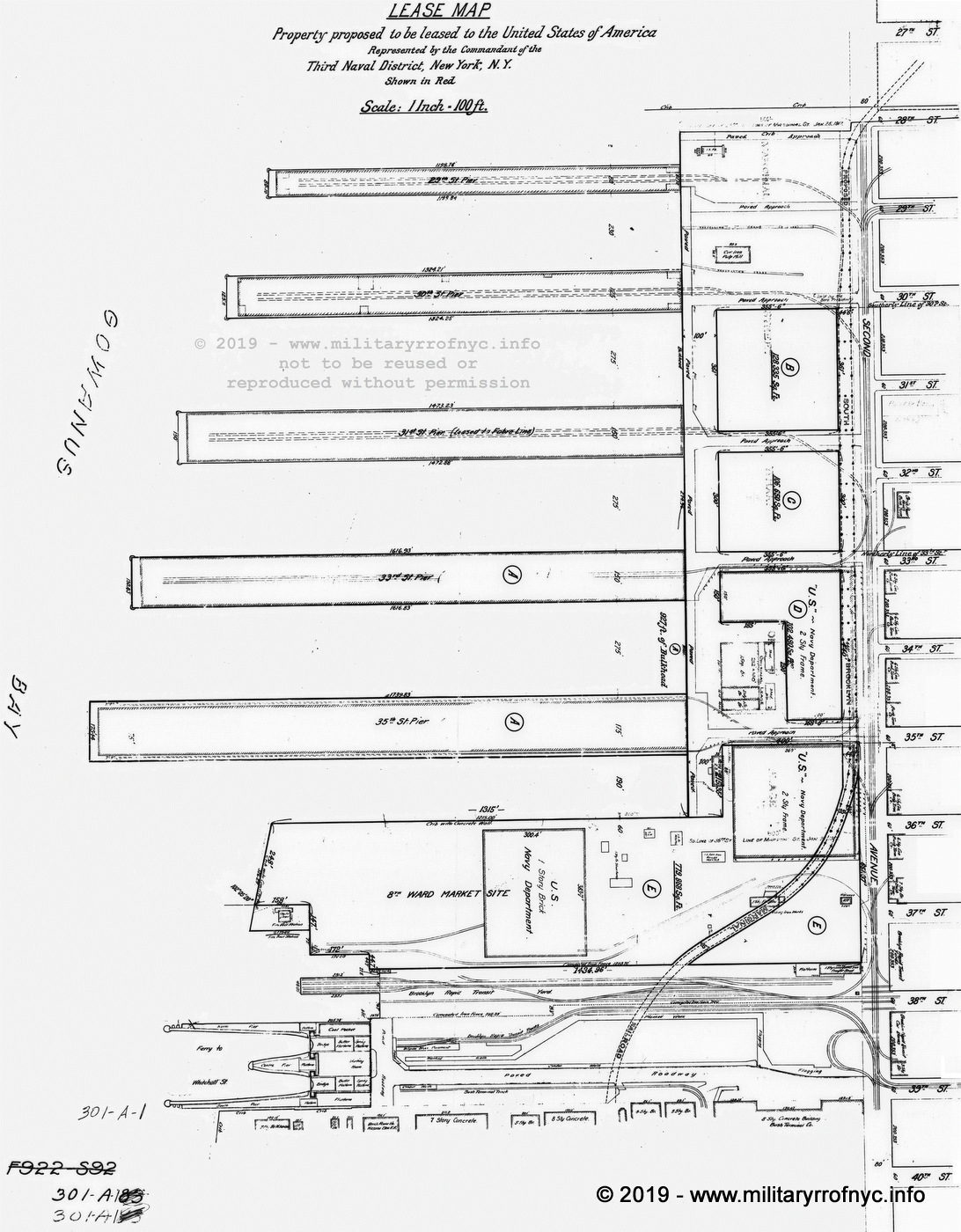
South Brooklyn Fleet Supply Base - Brooklyn, NY - August
1919
Library of Congress - Historic American Buildings Survey
Historic American Engineering
Records
added 02 January 2010
.
At the location between 36th and 38th Streets west of Second Avenue, you will see property marked "8th Ward Market Site" and a loop of track within that property. This trackage appears to be serviced by Bush Terminal RR for a farmers market once located there.
The following pages are from the book "A Record of Wartime Activities" - Turner Construction (1919) which is an accounting of construction projects undertaken by Turner Construction for the U.S. Government. It was published in 1919 and there is a great deal of interesting information within these pages of the Fleet Supply Base as well as other construction projects awarded to Turner Costruction. The applicable pages for the Fleet Supply Base are included here for your viewing:
.
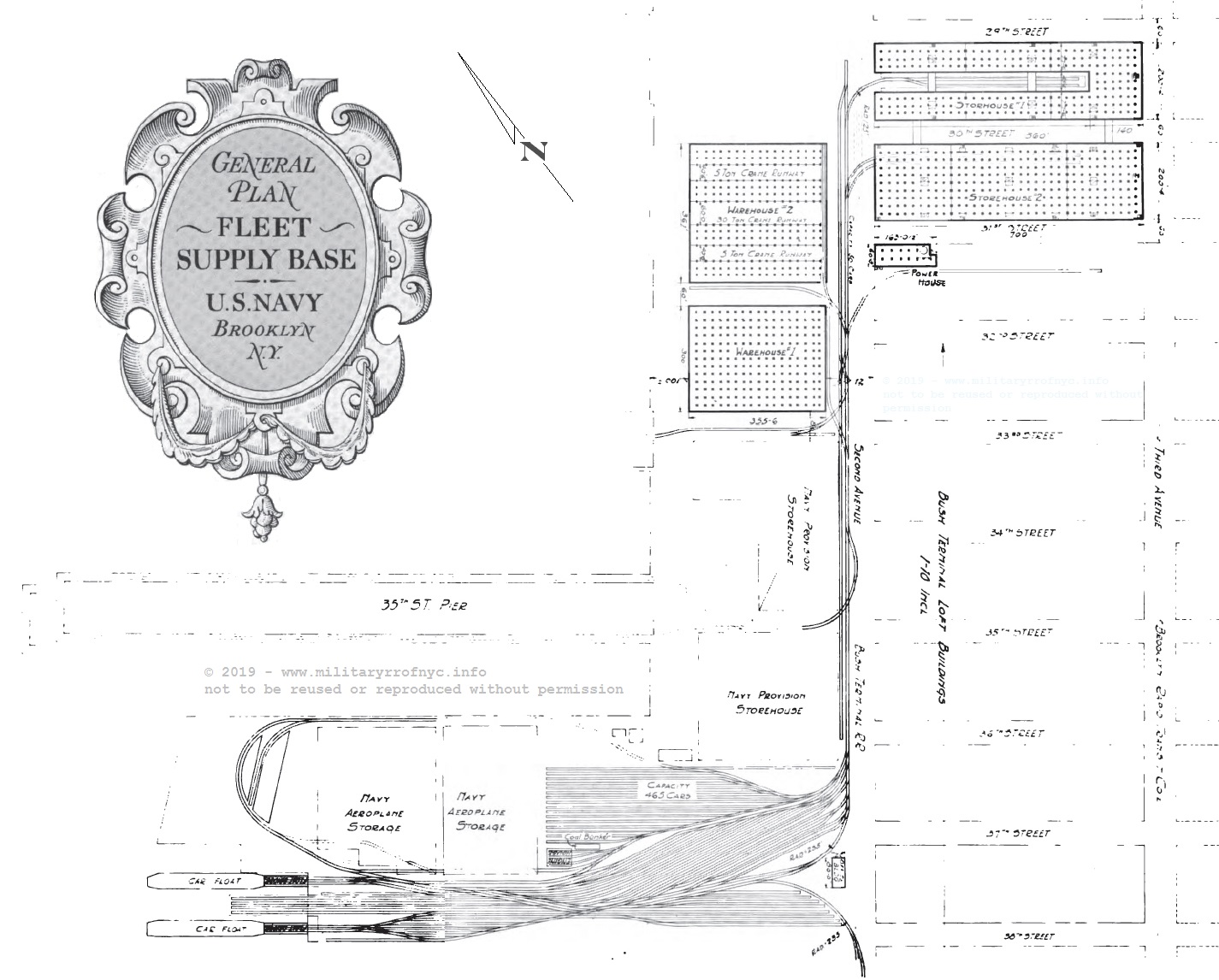 |
| . |
.......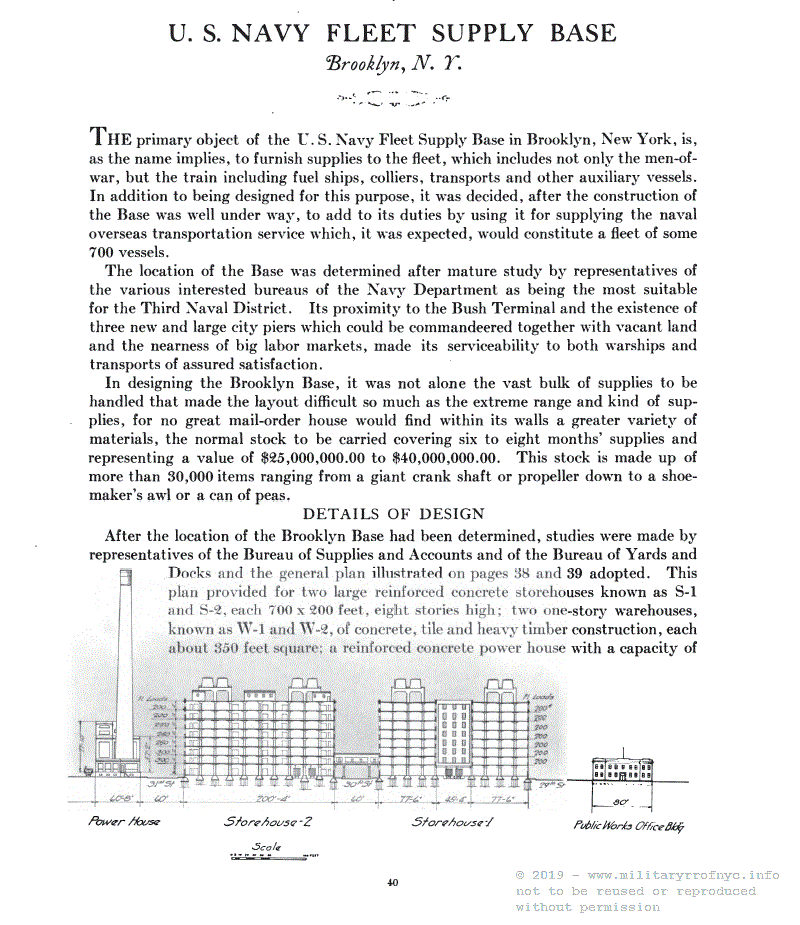 |
| . |
.......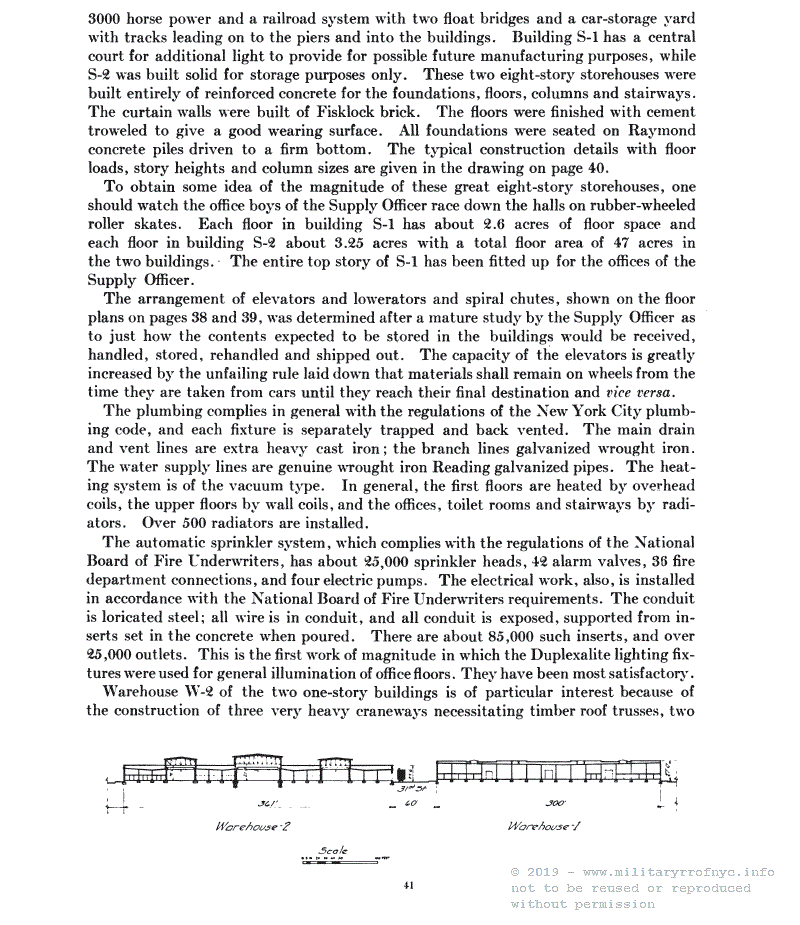 |
| . |
 |
| . |
....... |
| . |
.......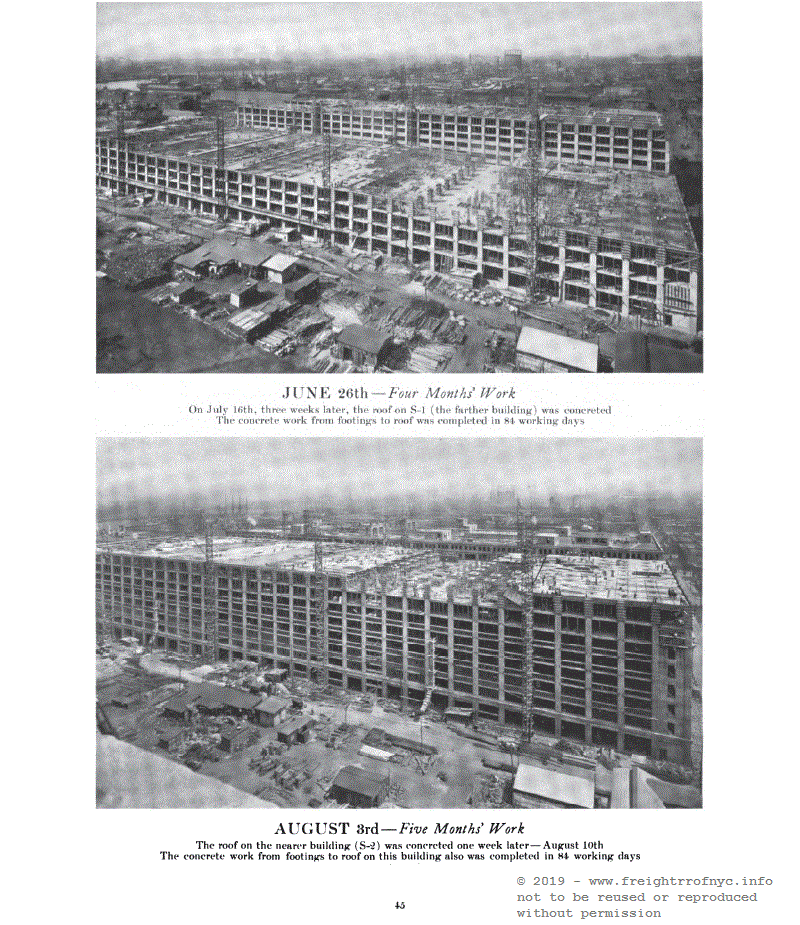 |
| . |
.......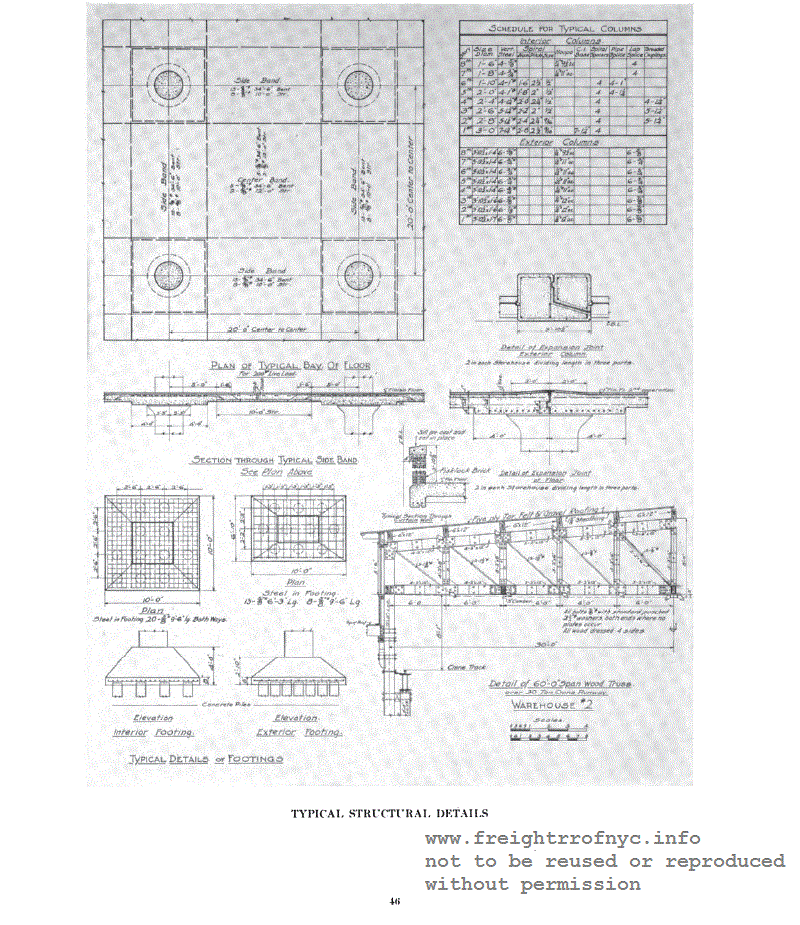 |
| . |
.......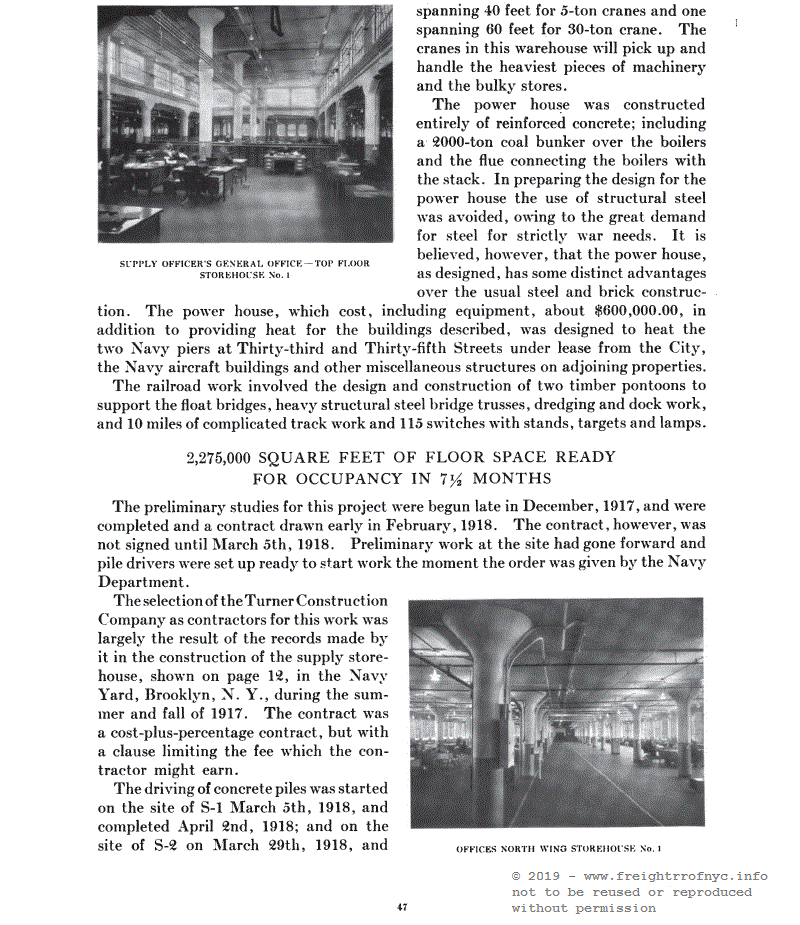 |
| . |
.......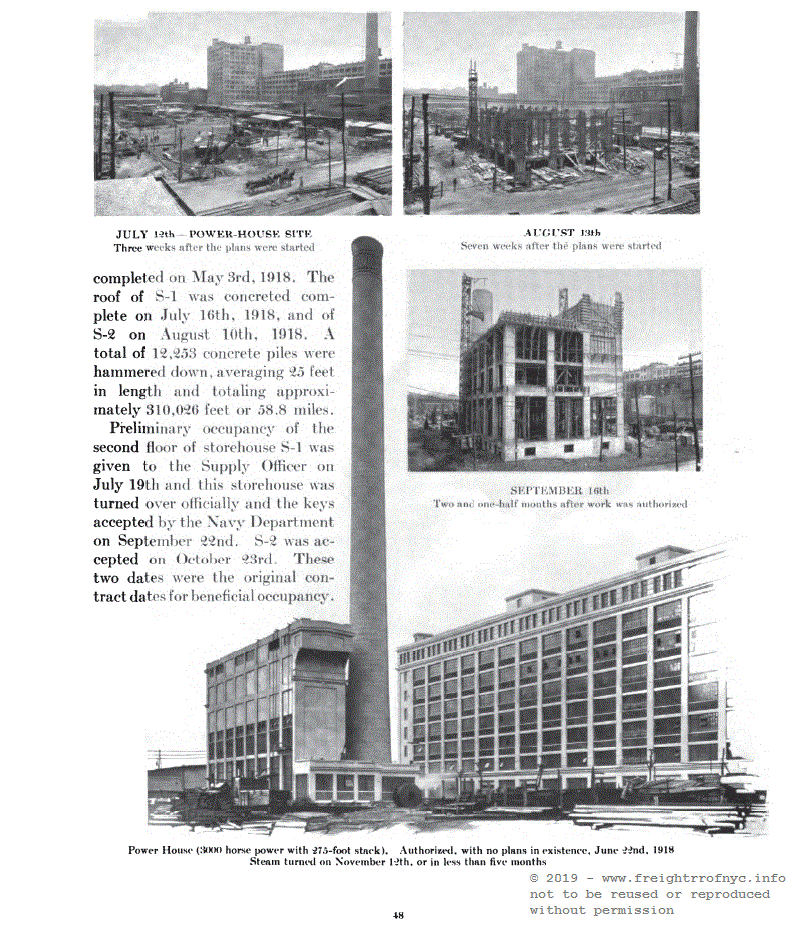 |
| . |
.......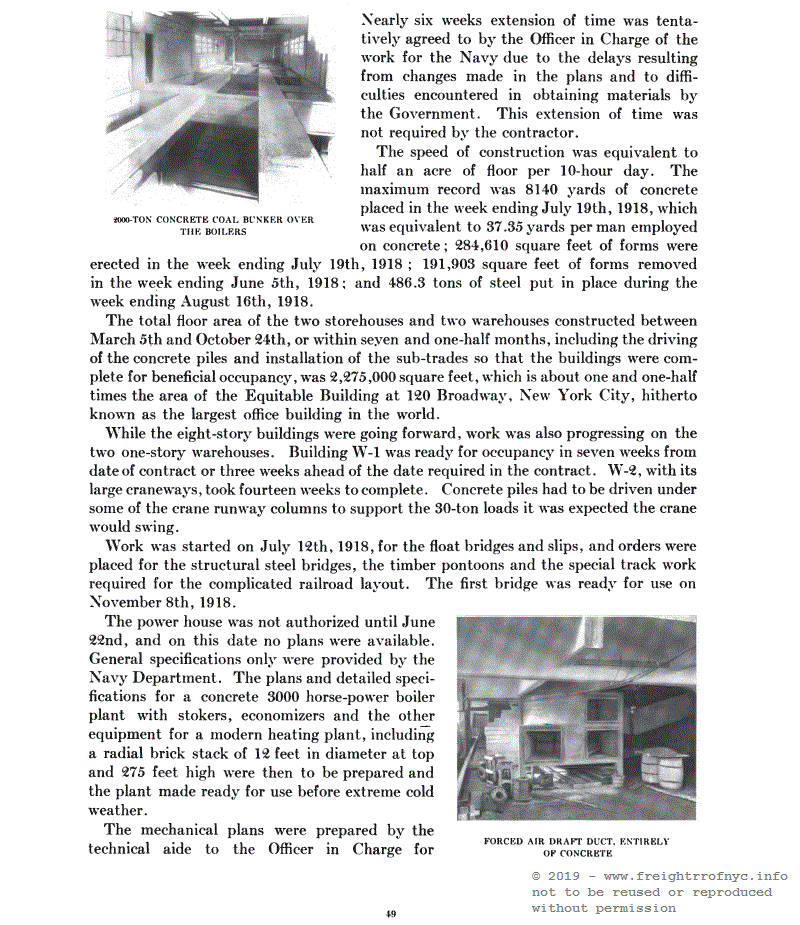 |
| . |
.......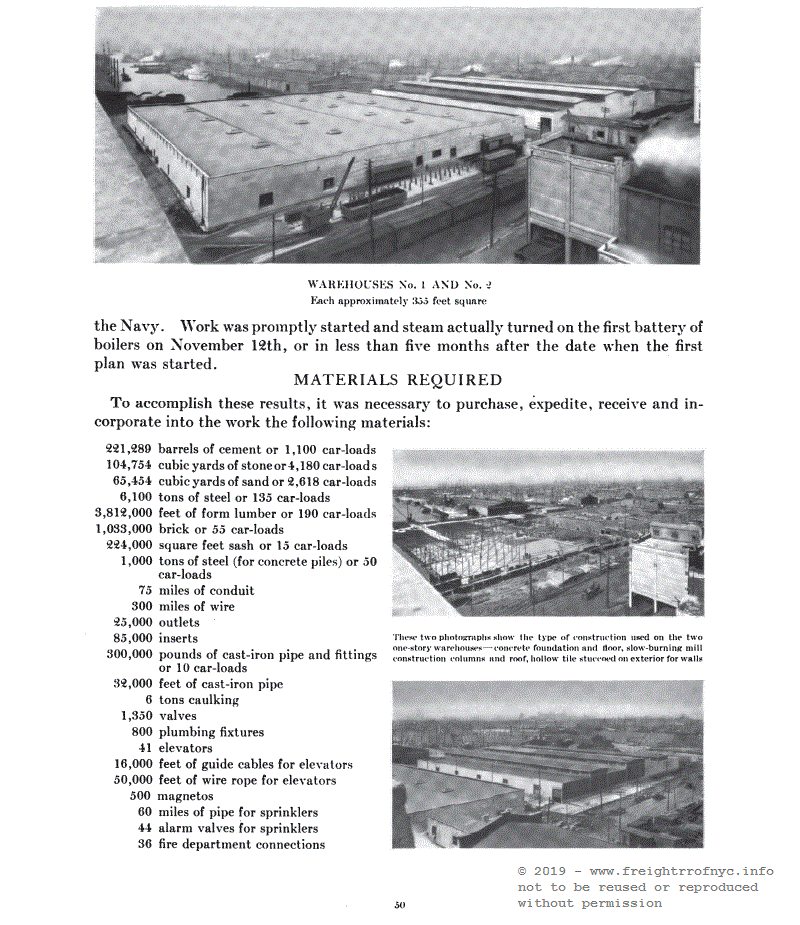 |
| . |
.......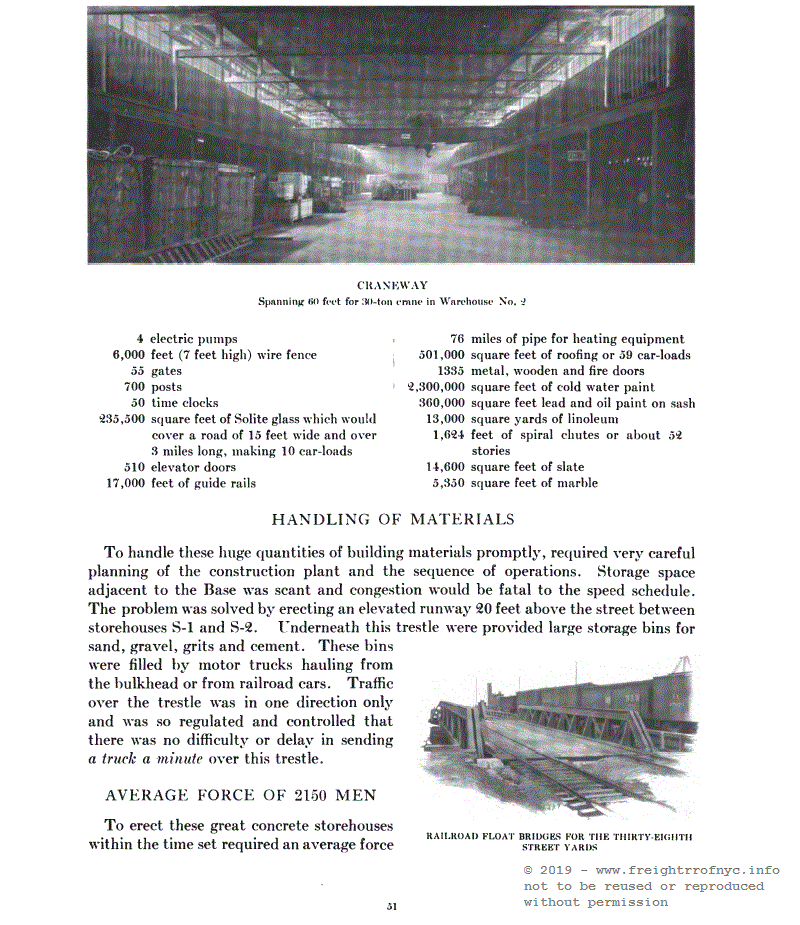 |
| . |
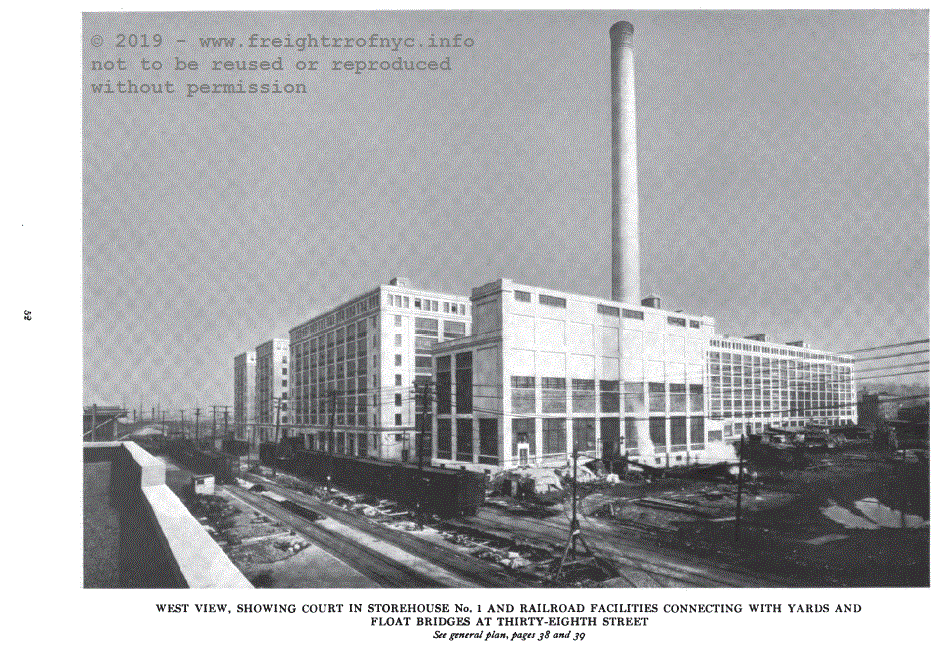 |
| . |
.......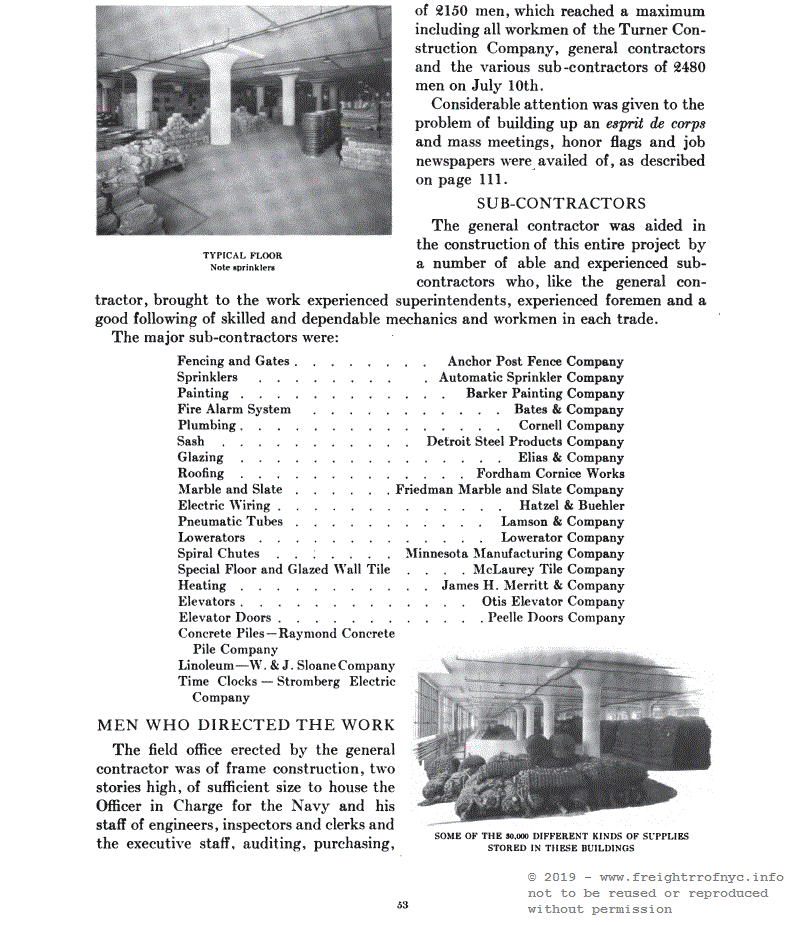 |
| . |
....... |
"A Record of Wartime Activities" - Turner Construction - 1919
.
.
Sometime after the construction of the Fleet Supply Base, a hearing was held before the Committee on Naval Affairs of the House of Representatives that questioned the expenditures. Testimony given by several persons relate minute detail about the need of the Fleet Supply Base, and its operation. It can be read in full detail here:
| Before A Committee on Naval Affairs of the House of Representatives on Estimates Submitted by the Secretary of the Navy - 1919, Part 2 |
Trackage & Float Bridges
.
The Library of Congress documents above reflect a rather large yard at the foot of 37th Street between Gowanus Bay and Second Avenue, with running trackage paralleling Bush Terminal Railroad trackage along Second Avenue.
The following map, associated with that digital collection is dated 1919 and seen below, shows the Navy has leased those structures shown in the lease proposal map above as well as a few others. It has also laid extensive trackage both with their property at 37th Street and along Second Avenue.
This trackage appears to have been laid upon the right of way of the proposed South Brooklyn Marginal Railroad, which never progressed to a construction stage. It is also learned that the Navy entered into an agreement with Bush Terninal to operate their own railroad, which did connect to the Bush Terminal Railroad.
Again, clicking in the image below will bring you to a large scale version for detailed viewing and it is a large file and may take a few moments to open. Click your back arrow to return you here:
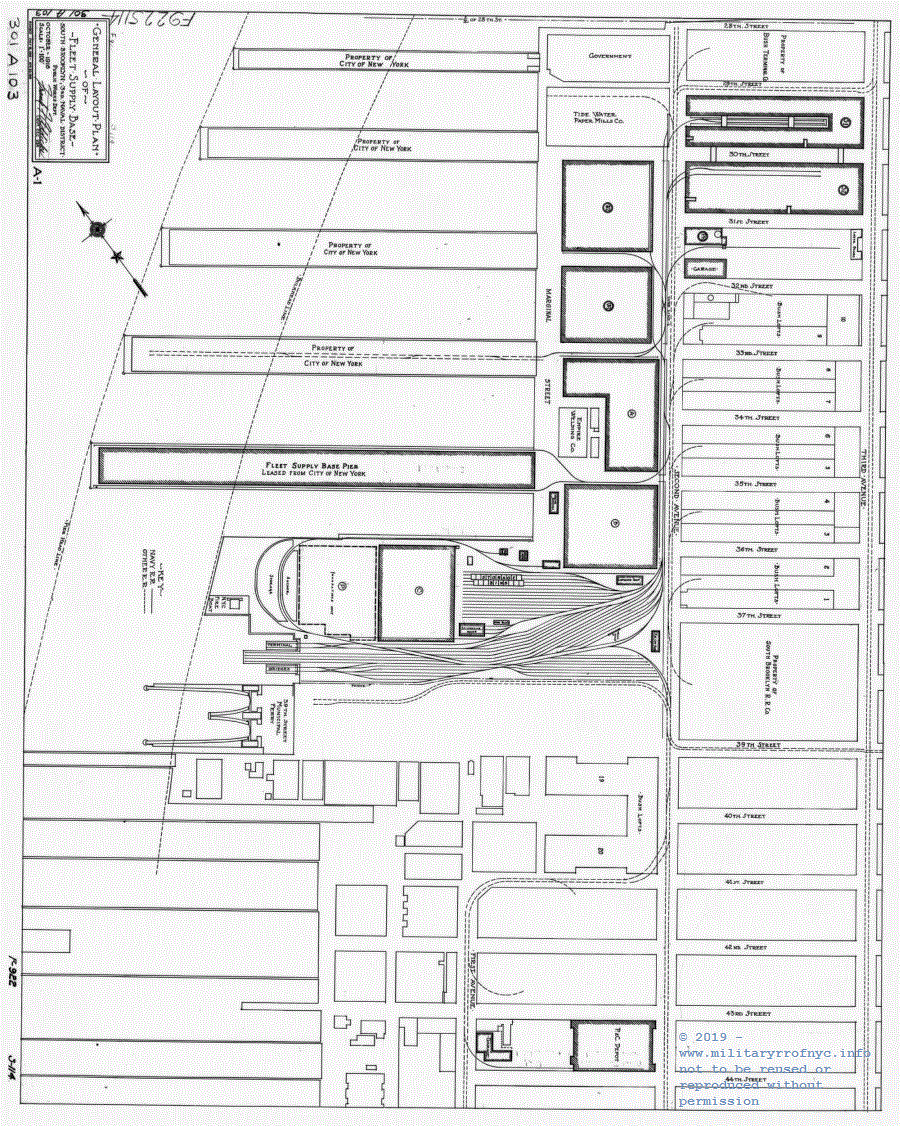
South Brooklyn Fleet Supply Base - Brooklyn, NY - August 1919
Library of Congress - Historic American Buildings Survey
Historic American Engineering
Records
added 02 January 2010
.
.
Of particular note is the fact that the Navy trackage serving the warehouses, pier and powerhouse operated by the Fleet Supply Base paralleled Bush Terminal trackage. While Bush Terminal trackage would run down the centerline of Second Avenue, Navy trackage ran along west of the curbline of Second Avenue, but there were three interchanges with Bush Terminal, one at 38th Street adjacent to the South Brooklyn Railway, and two at 34th Street.
The photo below shows the parallel track arrangement quite well. The spur shown is the siding located between 31st and 32nd Streets looking northeast:
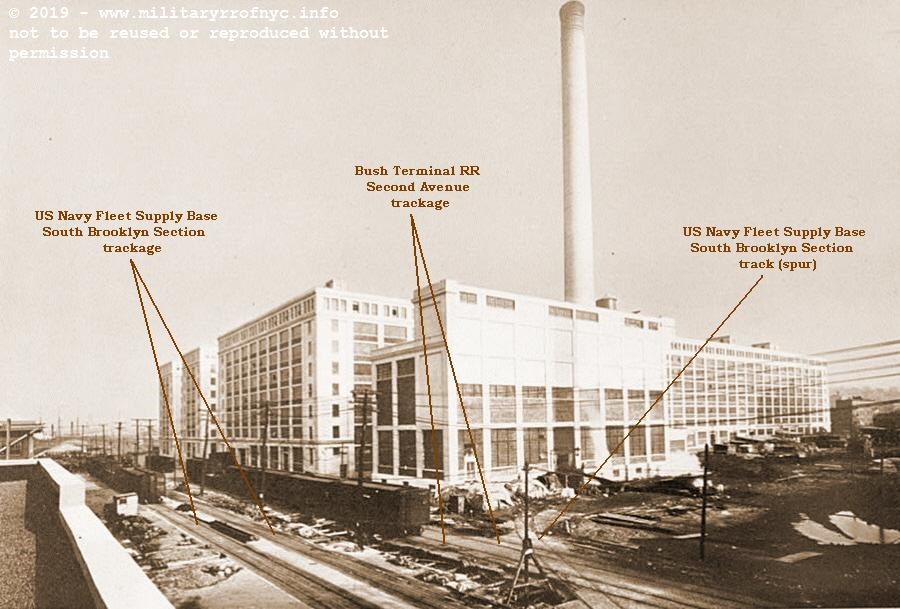
(unannotated version of this image below)
Turner Construction Company "Record of War Activities"
1918
(Caption is in error: this matches up to a view looking northeast on the
lease map,
and is looking at the power house and spur between 31st Street and 32nd Street
on Second Avenue.)
Library Of Congress archives
Historic American Buildings Survey / Historic American Engineering
Records
added 02 January 2010
.
.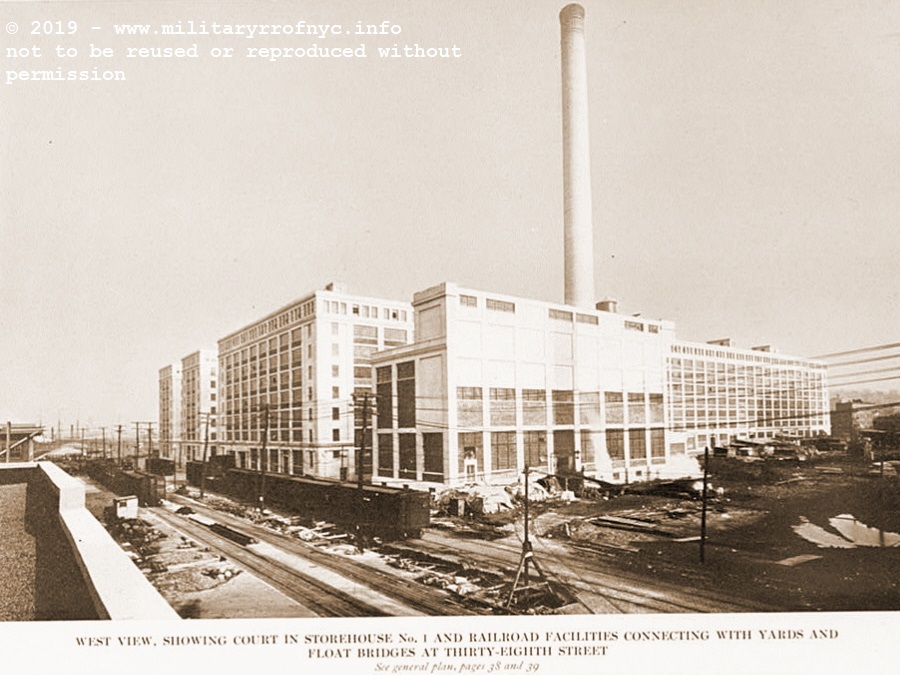
Turner Construction Company " Record of War Activities" 1918
(Caption is in error: this matches up to a view looking northeast on the
lease map,
and is looking at the power house and spur between 31st Street and 32nd Street
on Second Avenue.)
Library Of Congress archives
Historic American Buildings Survey / Historic American Engineering
Records
added 02 January 2010
.
.
It should be noted at this time that another small "P&C Depot" (Provisions & Clothing) was located between 43rd and 44th Street and First & Second Avenues. This location however appears to have been directly serviced by Bush Terminal RR up to the property line.
Numerous turnouts between the South Brooklyn Fleet Supply Base trackage and Bush Terminal RR trackage, as well as a connection to the South Brooklyn Railway at 39th Street is evident.
Also shown, is that one pier dedicated to the Fleet Supply Base (and leased from the City of New York) was equipped with a track along each edge outside of the actual piershed. The images below, while quite grainy, show these tracks. Another pier (one pier north) which was not leased by the Fleet Supply Base and operated by the City of New York and was equipped with trackage in the piershed. According to the map legend; trackage outside the piershed was operated by the US Navy (solid lines), but the trackage inside the piershed was City property (dashed lines). Judging from the map, it appears that the US Navy would have to provide rail service to that pier.
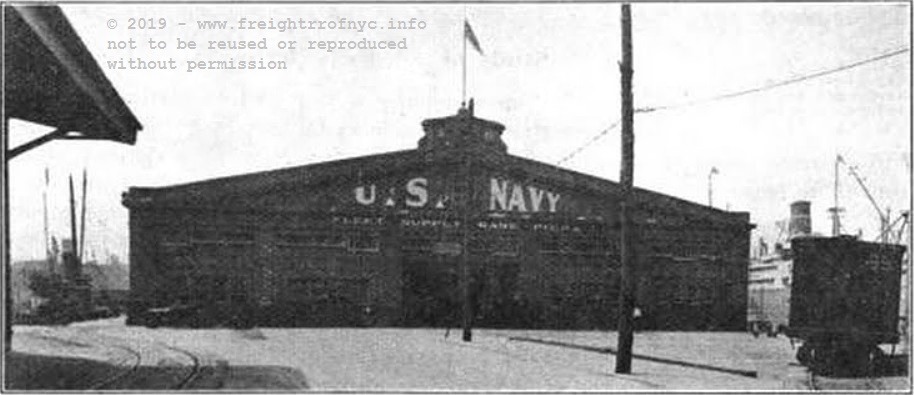
Shore End of Navy Base Pier at Thirty-ninth Street
"Joint Report with Comprehensive Plan
& Recommendations
New York & New Jersey Port & Harbor Development Commission, 1920"
.
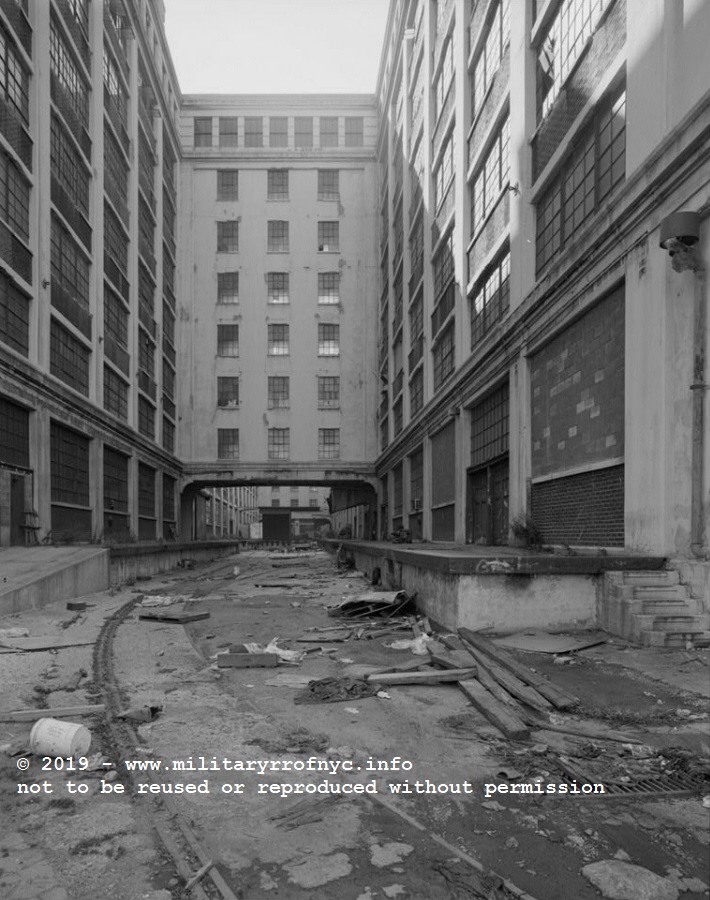
August 1991
R. Tucher photo
Library Of Congress archives
Historic American Buildings Survey / Historic American Engineering
Records
added 02 January 2010
.
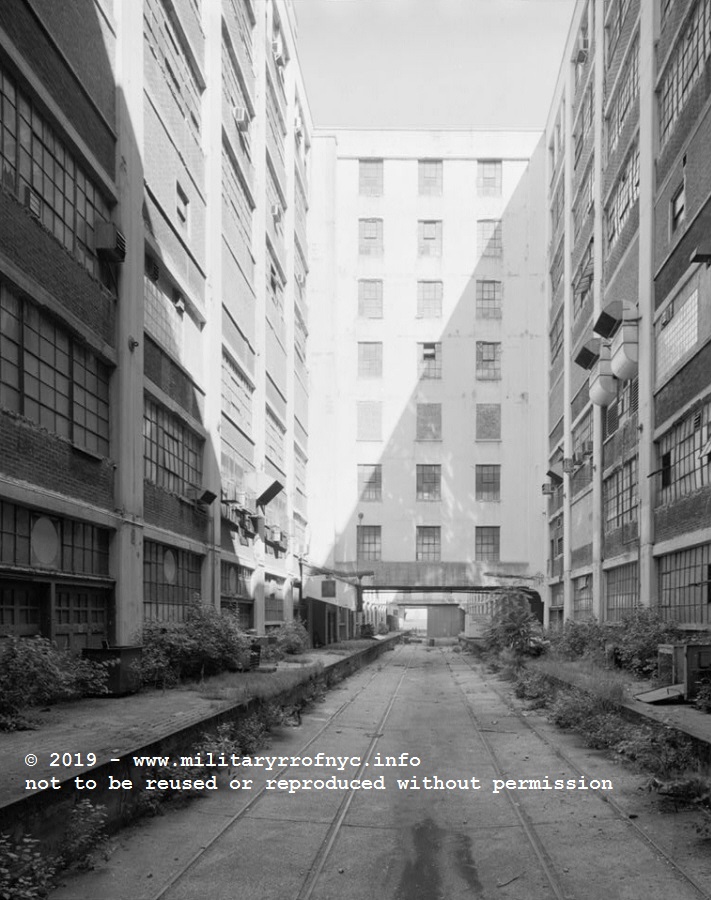
August 1991
R. Tucher photo
Library Of Congress archives
Historic American Buildings Survey / Historic American Engineering
Records
added 02 January 2010
.
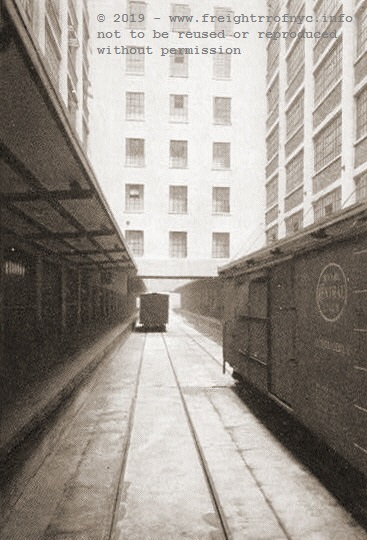
1918
"Court in Storehouse #1 showing loading platforms & connecting
bridge"
Library Of Congress archives
Historic American Buildings Survey / Historic American Engineering
Records
added 02 January 2010
.
Also of particular interest, is the fact that two float bridges were installed at what hypothetically would be considered the foot of 38th Street, had that street continued to the water.
From the image on page 51 of the Turner Construction brochure, shows a Pony Truss float bridge. (There were a pair of them in fact.)
I have only included photos from the record archive that have railroad related subject matter. Many more photographs of the construction phase and completed structures can be viewed at:
The existence of the railroad at the Fleet Supply Base was quite short: its wartime operational history was very shortlived, as upon the signing of the Armistice and the conclusion of World War I in November 1918, the Fleet Supply Base was now superfluous and the Navy began divesting portions of it quickly thereafter. The storehouses and powerplant were retained, but all of the property leased from the City of New York south of 33rd Street was returned to the City in 1921. The remainder of the property, containing the two storehouses were conveyed to the City in 1929.
The Navy still maintained a presence on the property, but the Fleet Supply Base Railroad was no longer needed, so the yard tracks torn up and the locomotives sold (two of which we know went to Brooklyn Eastern District Terminal). The sidings on the piers were connected to Bush Terminal Railroad trackage and BTRR would commence in servicing the customers on those piers.
As seen by the issue of the 1932 Port Facilities Map, the remaining US Navy (#509) trackage was at a minimum.
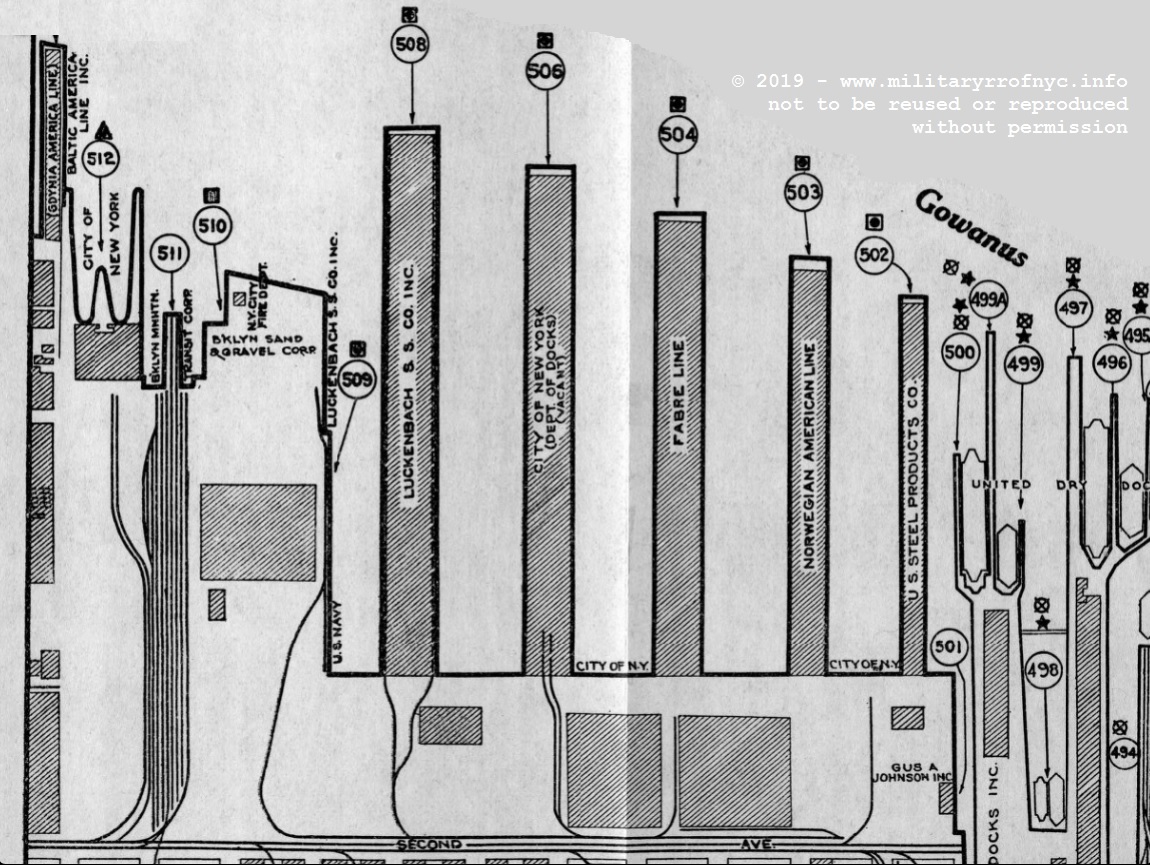
Locomotives
| It should be noted here and now
that while they were originally thought by many previous railfans, historians
& rosters; that the two surviving locomotives #3 & #4 (BEDT #12 & 13) were part of the Brooklyn Navy Yard
roster by the lettering on the side tank: "U. S. NAVY" and "BROOKLYN". . However that attribution has now been determined to be incorrect. . The Fleet Supply Base was a separate Naval facility from the U. S. Navy Yard. |
Two obvious observations bear out this point:
The first, the very lettering on the locomotives. The Fleet Supply Base was in fact located in South Brooklyn (the Sunset Park neighborhood to be precise), while the Brooklyn Navy Yard was located in Northern Brooklyn (in the Vinegar Hill neighborhood, almost by Williamsburg). It most certainly can be accepted and even understood those people not native to Brooklyn would not immediately recognize this difference in geographic location. Brooklyn is Brooklyn right? "Brooklyn" and "Navy" equal Brooklyn Navy Yard, right? It's like when you say you are from New York. People picture bridges, the skyscrapers, the Staue of Liberty and say, "Oh you're from New York City.." No, New York.
There is vast whole other geographical area that comprises up the State of New York. New York City is just one part of it. And when referring to New York City, Few people today realize there are five different boroughs and hundreds of defined neighborhoods in New York City, each one with its own identity (and character)! Even New York State residents say they are going to "The City" when in fact they may be going to Queens, or Brooklyn or Staten Island. And I am guilty of this ambiguity as well. Hell, I lived in Brooklyn from birth to 1998, but when I was going to Manhattan, I was going to "the City". Not Manhattan, but "the City".
The second being, the
locomotives for the Brooklyn Navy Yard were clearly marked as such:
"New York Naval Shipyard", "Navy Yard New York", etc. However, the
locomotives assigned to this Fleet Supply Base were clearly marked
"South Brooklyn Section". Why define a separate location or section, if
it was part of the Navy Yard? That is because it wasn't part of the
Navy Yard. The Navy Yard was the Navy Yard and the South Brooklyn
Section the Fleet Supply Base. Why these locomotives were painted
South Brooklyn Section
and
not Navy Yard (as all the other Navy Yard locomotives had been) had been
puzzling. But with the discovery and research into this facility located
in South Brooklyn, the question is answered.
But like any well established and long lived assumption, it
proves harder to change that established belief later, when it is found
out it is in error. Remember the quote, "A lie gets half way around the
world before the truth has a chance to put its pants on." It's often
attributed to Winston Churchill. And the line has grown and evolved
— and then credited to different people — many times over
hundreds of years, potentially starting with a version by Swift in 1710.
Winston is lot more recognizable than Swift, so
thats the name people remember despite how many times it has been proved
Winston never said it. "You can lead a horse to water..." Oh, never
mind.
Returning to the locomotives, we know of at least two steam locomotives that operated at this location with the very strong possibility of four.
As seen below, the H. K. Porter builders photo of #3 and #4 shows their livery from H. K. Porter to be "U. S. Navy South Brooklyn Section". These two locomotives were part a four unit order of identical locomotives made by the US Navy.
We also know that this locomotive below (c/n 6368) and one other sister (c/n 6369) would eventually be purchased by the Brooklyn Eastern District Terminal in 1922. This date coincides with the closing of the Fleet Supply Base. What became of the other two locomotives (c/n 6366 and c/n 6367) from this order remains unknown.
Fortunately, the two sisters that were purchased by the Brooklyn Eastern District Terminal survive to this day with #3 (BEDT #12) in Parrish, Florida at the Florida Railroad Museum, and #4 (BEDT #13) at Age of Steam Roundhouse in Sugarcreek, Ohio.
Age of Steam even went so far as to cosmetically restore their
locomotive and return it to her original U.S. Navy South Brooklyn
Section livery (albeit with her BEDT improvements intact: Pyle steam
generator, Pyle electric headlamp, oil bunker and cast steel bumpers.)
| H. K. PortER BLUEPRINTS FOR US NAVY - SOUTH BROOKLYN SECTION #1, 2, 3, 4 |
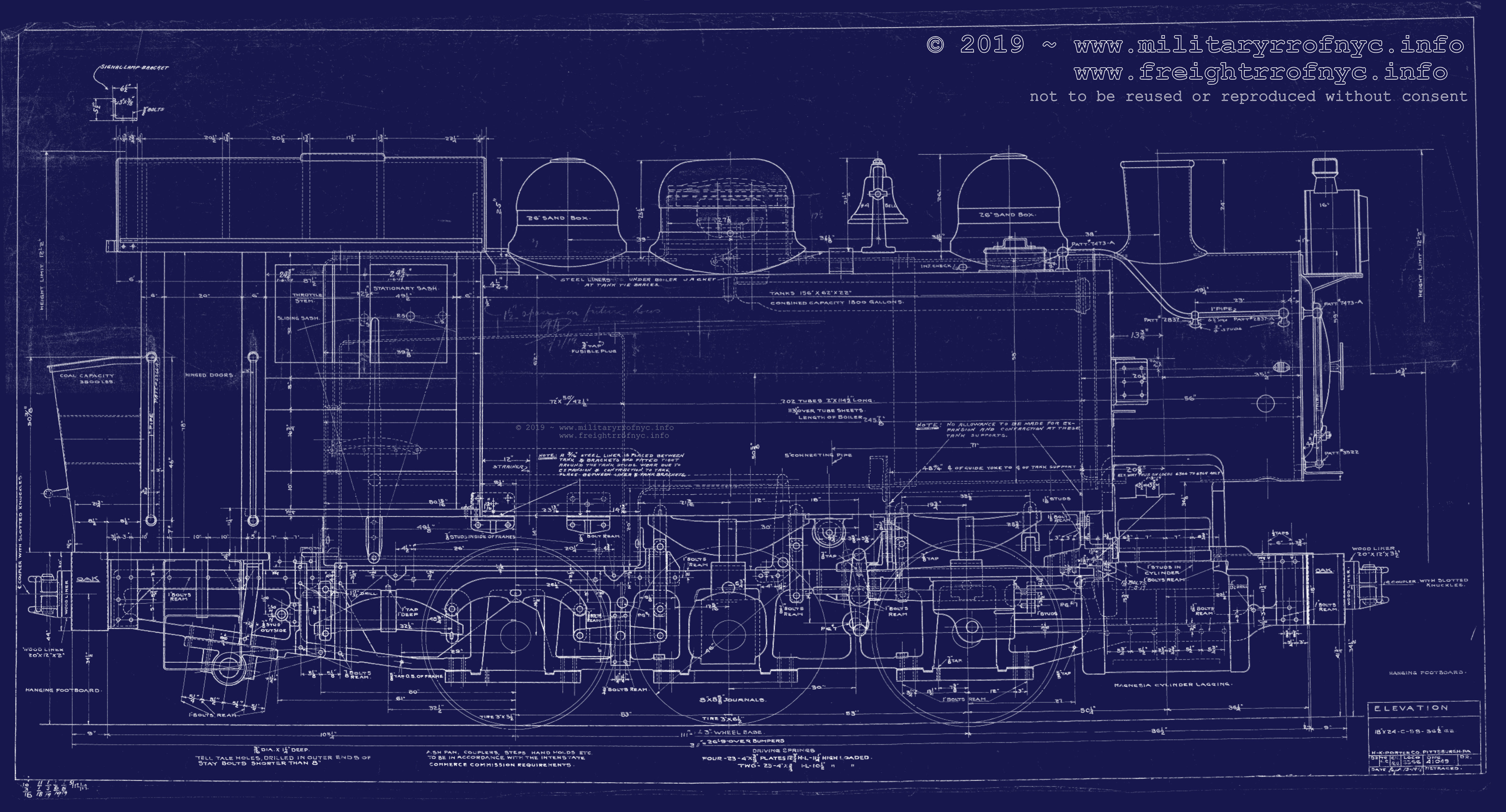 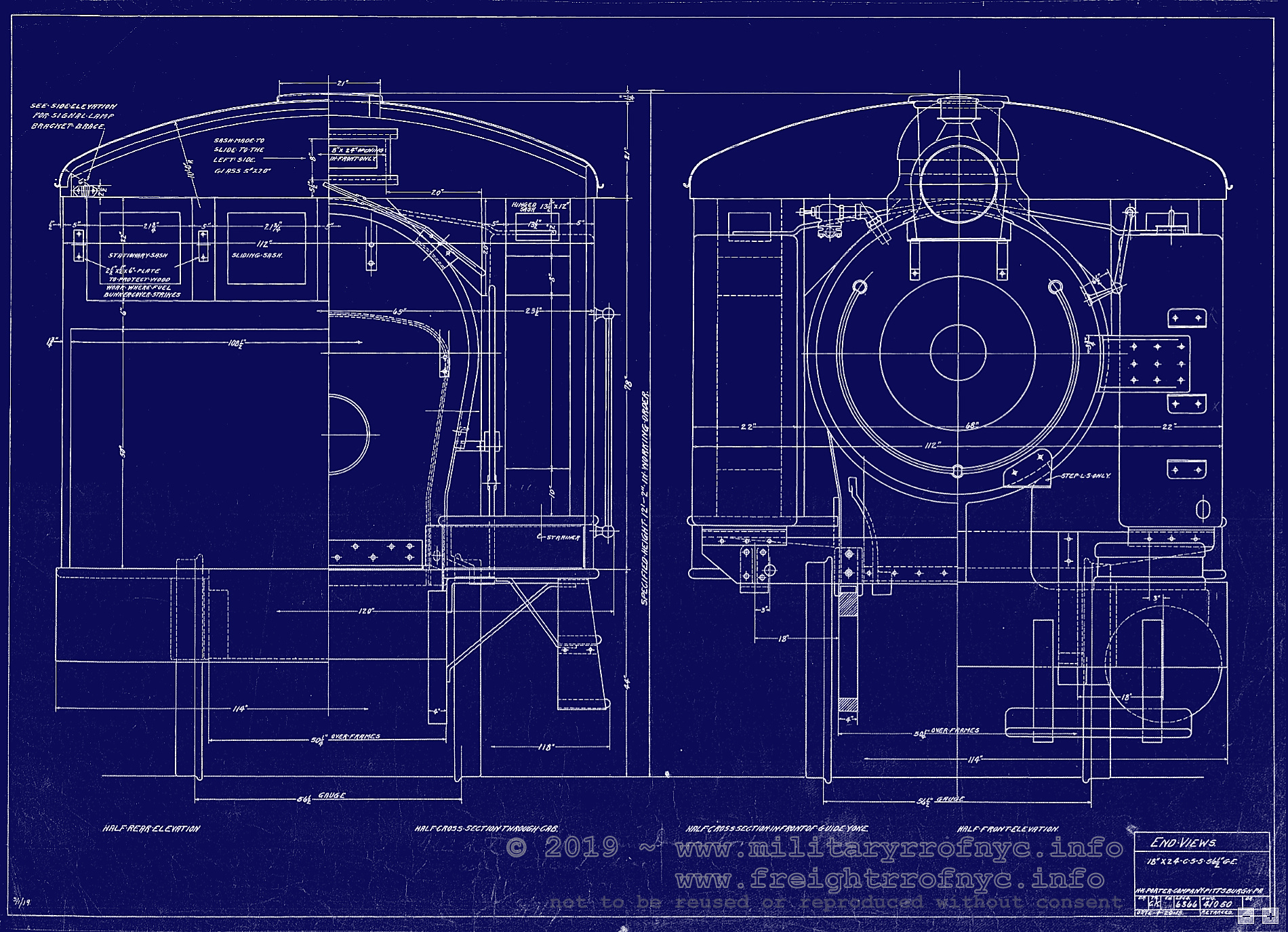 H. K. Porter blueprints for U. S. Navy Fleet Supply Base - South Brooklyn Section Locomotives 1, 2, 3, 4 c/n 6366, 6367, 6368, 6369 originals reside in Canadian Science & Technology Museum, Ottawa, CA hi resolution scans purchased and in authors collection added 17 May 2019 |
| .
. |
| 3 |
|
| .
. |
|
| .
. |
| 4 |
|
| .
. |
|
| .
. |
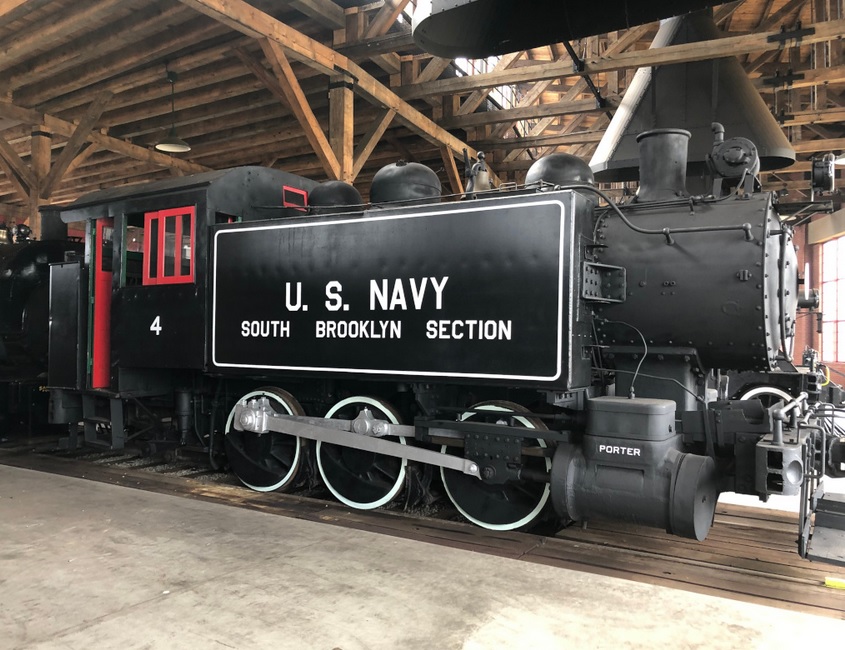 #4 - present day Age of Steam Roundhouse, Sugarcreek, OH Age of Steam Roundhouse photo |
.
...
South Brooklyn Navy Fleet Supply
Base Steam Locomotive Roster
builder |
c/n |
build date |
gauge |
wheel arrangement |
wheel dia |
cylinders |
acquired |
number | disposition |
notes |
ref |
| H. K. Porter | 6366 | 3/1919 | std. | 0-6-0T | 46" | 18" x 24" | new | #1 | unknown | wgt:
128,000 lbs. ¤ |
[3] |
| H. K. Porter | 6367 | 4/1919 | std. | 0-6-0T | 46" | 18" x 24" | new | #2 | unknown | wgt: 128,000 lbs. ¤ |
[3] |
| H. K. Porter | 6368 | 3/1919 | std. | 0-6-0T | 46" | 18" x 24" | new | #3 | 1922: to Brooklyn Eastern District Terminal
#12; 6/1963: to R. Ziel; New York, NY 3/1971: to R. Most; Tampa, FL currently on display at Florida RR Museum, Parrish FL |
wgt: 128,000 lbs. ¤ |
[3] [11] |
| H. K. Porter | 6369 | 3/1919 | std. | 0-6-0T | 46" | 18" x 24" | new | #4 | 1922: to Brooklyn Eastern District
Terminal #13; 10/1963: to George Hart; 12/1976: to RR Museum of Pennsylvania; 12/2011: Age of Steam Roundhouse Jerry Jacobson; Sugarcreek , OH cosmetically restored to US Navy South Brooklyn Section livery |
wgt: 128,000 lbs. |
[3] [11] |
Locomotive Footnotes:
¤
= these four locomotives have consecutive construction numbers: 6366, 6367,
6368, 6369;
and are identical sisters. C/n's 6368 and 6369 to BEDT #12 and #13 respectively.
Disposition of c/n's 6366 and 6367 are unknown.
Index:
Military
Railroads of the New York Metropolitan AreA | ||||
| EARLE N.A.D. N.W.S. EARLE | ||||
| FORT TOTTEN | Fort Terry | Fort Hancock / SANDY HOOK PROVING GROUNDS | ||
| . SIGN THE GUESTBOOK | ||||
.